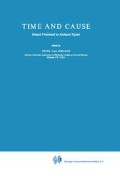Abstract
Consider the following claims about causal simultaneity.
Access this chapter
Tax calculation will be finalised at checkout
Purchases are for personal use only
Preview
Unable to display preview. Download preview PDF.
Notes
Richard Taylor, Action and Purpose, Prentice-Hall, Englewood Cliffs, N.J., 1966, pp. 9–39, esp. pp. 35–39.
Richard Taylor, `Causation’, Monist47 (1963), 287–313, esp. pp. 303–313, reprinted in Myles Brand (ed.), The Nature of Causation, University of Illinois Press, Urbana, 1976, pp. 277–305; and Bertrand Russell, `On the Notion of Cause’, in Mysticism and Logic, Doubleday, Garden City, N.Y., 1917.
Wesley Sahnon, `An “At-At” Theory of Causal Influence’, Philosophy of Science 44
215–224; Patrick Suppes, A Probabilistic Theory of Causality, North-Holland Publishing, Amsterdam, 1970.
For reviews of historical and contemporary attempts to account for causal asymmetry, see Myles Brand, `Causality’, in P. Asquith and H. E. Kyburg, Jr. (eds.), Current Research in Philosophy of Science, Philosophy of Science Association, East Lansing, Mich., 1979; and Richard Taylor, `Causation’ in Paul Edwards (ed.), The Encyclopedia of Philosophy, 8 vols., Macmillan and Free Press, New York, 1967, Vol. 2, pp. 56–66.
Action and Purpose, pp. 35–36.
See, for example, Taylor’s discussions in Monist, and Action and Purpose; and J. L. Mackie, `Causes and Conditions’, American Philosophical Quarterly 2(1965), 245-264, reprinted, among other places, in Brand (ed.), op. cit., pp. 307-344. Cf. Jaegwon Kim, `Causes and Events_ Mackie on Causation’, Journal of Philosophy 68(1971), 426 - 441.
For a survey of these views, see Mackie, The Cement of the Universe, Oxford University Press, London, 1974, Chap. 10.
Donald Davidson, `Causal Relations’, Journal of Philosophy 64(1967), 691–703, reprinted, among other places, in Brand (ed.), op. cit., pp. 354–367; and `The Individuation of Events’, in N. Rescher et al. (eds.), Essay in Honor of Carl G. Hempel, Reidel, Dordrecht, 1970, pp. 216-234.
Encyclopedia of Philosophy, p. 65; Taylor makes the same point in Monist, p. 309 and Action and Purpose, pp. 35–36.
Monist, p. 311.
Action and Purpose, p. 38.
A Treatise of Human Nature 1.3.2, ed. by L. A. Selby-Bigge, Oxford University Press, London, 1888, p. 76. For an interesting interpretation of this argument, see Stanley Munsat, ‘Hume’s Argument That Causes Must Precede Their Effects’, Philosophical Studies 22 (1971), 24–26.
Taylor uses a similar example. Suppose that a person is holding a pencil, then the movement of his hand causes the movement of the pencil. See: Action and Purpose, p. 36; Encyclopedia of Philosophy, p. 65; Monist, pp. 309–310.
It is difficult to see how, for instance, an increasing gravitational field can be construed as involving material objects. The cause of such an event might well involve material objects, but the event of the field’s increasing in strength appears devoid of material objects. If events of this sort do not involve material objects, then the view that all events involve material objects, held by Kim and others, is mistaken — cf. Jaegwon Kim, `Events as Property Exemplifications’, in M. Brand and D. Walton (eds.), Action Theory, Reidel, Dordrecht, 1976, pp. 159–177.
Cf. Alexander Rosenberg, `Propter Hoc, Ergo post Hoc’, American Philosophical Quarterly 12 (1975), 245–254, esp. pp. 252–253.
Brand, `Particulars, Events and Actions’, in Brand and Walton, op. cit., pp. 135–156; and `Identity Conditions for Events’, American Philosophical Quarterly 14 (1977), 329–337.
Note that describing events using this canonical form does not commit us to Kim’s view of the internal structure of events. (Actually, Kim’s canonical form is not exactly the one used here; he includes a temporal specification, but not a spatial one.)
See Alvin Goldman, A Theory of Human Action, Prentice-Hall, Englewood Cliffs, N.J., 1970. Judith Jarvis Thomson’s Acts and Other Events, Cornell University Press, Ithaca, N.Y., 1977, contains an extended, original and provocative discussion on parts of events.
Salmon, op. cit., follows Hans Reichenbach in The Direction of Time, ed. by Maria Reichenbach, University of California Press, Berkeley, 1956, esp. Sections 22–23, in using the terms `causal interaction’ and `causal process’. There is considerable difference between my use of the terms and Salmon’s and Reichenbach’s, though there are also some underlying affinities. Some of the differences stem from different notions of events.
For a discussion of Cambridge changes, see Kim, ‘Noncausal Connection’, Noüs8 (1974), 41–52.
I have found helpful the comments of Ralf Meerbote, Marshall Swain, Paul Teller and Irving Thalberg on an early draft. I have also profited by discussing these issues with a number of my colleagues, especially Daniel Berger, and with members of the audiences at the University of Cincinnati, Ohio, and the Somona State Action Theory Conference.
Author information
Authors and Affiliations
Editor information
Editors and Affiliations
Rights and permissions
Copyright information
© 1980 Springer Science+Business Media Dordrecht
About this chapter
Cite this chapter
Brand, M. (1980). Simultaneous Causation. In: Van Inwagen, P. (eds) Time and Cause. Philosophical Studies Series in Philosophy, vol 19. Springer, Dordrecht. https://doi.org/10.1007/978-94-017-3528-5_8
Download citation
DOI: https://doi.org/10.1007/978-94-017-3528-5_8
Publisher Name: Springer, Dordrecht
Print ISBN: 978-90-481-8358-6
Online ISBN: 978-94-017-3528-5
eBook Packages: Springer Book Archive

